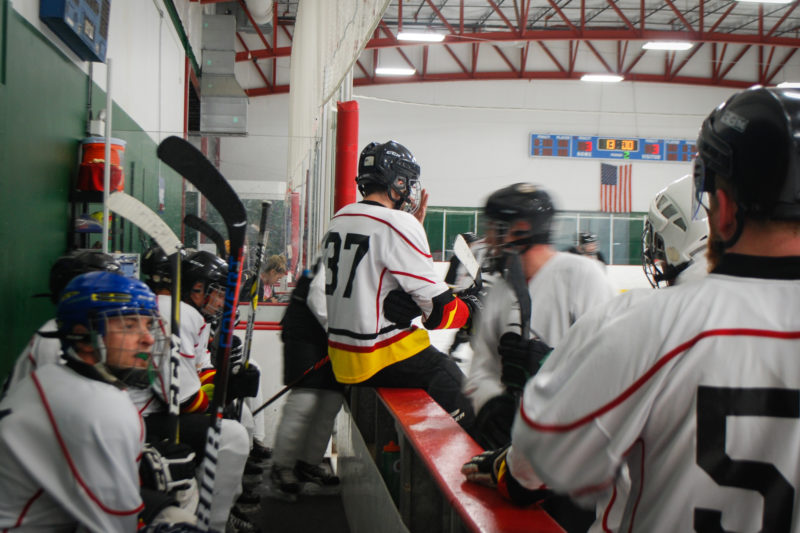Recreational League Hockey Heats Up in Austin
By Shepard Price
Reporting Texas

Members of Puck Dynasty, an adult league hockey team at Chaparral Ice, wait for play to resume during an intermission on Oct. 22, 2018. Shepard Price/Reporting Texas.
On a Thursday evening in October, Lenard Swain was seemingly flying over the ice, whipping past defenders. Swain, 46, is one of the better players in a rapidly growing community of recreational hockey players in Austin. On skates he’s faster than most players and more creative when it comes to getting the puck into a good position to score.
“It’s the greatest sport that’s ever been created — fast pace, non-stop action, contact,” Swain said. “Everything people like about football you get at 10 times the speed.”
In a Sun Belt city whose sports culture is dominated by college football and basketball, more people are playing hockey than ever before. Hockey aficionados say there are two main reasons for the sport’s surge in popularity: Austin’s booming economy, which has attracted northerners who grew up with the sport, and the success of the Texas Stars, a Cedar Park-based professional hockey team that plays in the American Hockey League.
Jason Maurer directs the recreational leagues at Chaparral Ice, an ice rink located in a nondescript strip mall in North Austin. The number of recreational players at the rink has grown by close to 10 percent a year during the last half-decade, Mauer said, and almost 600 people played adult recreational league hockey at Chaparral Ice in 2017. According to USA Hockey, the sport’s governing body, more than 180,000 U.S. adults played hockey in recreation leagues around the country during the 2016-17 season, up 74 percent from a decade ago.
At Chaparral Ice, players said they play for the camraderie and exercise.
“It’s great exercise,” said Todd Paricio, 54. Paricio, who works as an anaestheologist, grew up in a small town in New York. “The adrenaline rush you get from going zero to 180 in three seconds is great. You’re going constantly. You keep your feet moving, keep your head up. The technical challenge of keeping the puck on your stick — it’s eight ounces, it’s subtle,” Paricio said.
“It’s not about winning, losing, scoring goals or not. It’s about the friendships you make,” 56-year-old Jacques Mailhot said. Mailhot, who is retired, grew up in Quebec and played almost 15 years of professional hockey, including a short stint in the National Hockey League with the Quebec Nordiques in 1988. Despite Mailhot’s impressive hockey pedigree, some of his competitors at Chaparral Ice are as skilled as he, Mailhot said. In fact, more than a dozen players at the rink played in either the elite Canadian junior hockey system or at the college level in the U.S.
“You get to be a kid for an hour, hour and a half,” Mailhot said. “Hanging out in the locker room, getting a beer … mainly the friendship, it’s what I missed from my playing days.”
Austin is one of the fastest-growing large cities in the country, and many new arrivals come from cities and towns in colder climates, places where hockey is popular.
“The reason we have such good hockey here is the technology that’s here,” said 47-year-old Chris Kendall. Kendall plays at both Chaparral Ice and The Pond, another ice rink in North Austin. “We’ve got the tech that brings a lot of guys from Canada, a lot of guys from the Northeast. Without those guys, I wouldn’t be playing at the level I’m playing at.”
Chaparral Ice and The Pond are only two miles away from each other, and the proximity has inspired a sense of community and friendly rivalry, players say.
“There’s a lot of crossover,” said Maurer, the league director at Chaparral Ice. “We schedule our league games on nights that are not conflicting with theirs so they don’t have to pick one over the other, so there’s a lot of people that do both.”
Both Chaparral and The Pond play a similar style of hockey — three 13-minute periods broken up by two-minute intermissions. The rules bar fighting, referees call very few penalties, and whistles for stoppages of play are rare. Leagues are divided into six divisions based on skill. The best players, such as Mailhot, play in the highest level, called “AA.” Chaparral Ice is stricter about who plays in which league, while The Pond lets players select their own divisions.
Mailhot said he’s seen interest in hockey steadily increase during the 22 years he’s lived in Texas. He attributes the growth to Austin’s booming population and to the arrival of professional teams such as the Texas Stars, who moved to the Austin area in 201o.
“It’s all about having the right environment,” Mailhot said. The environment, he said, is right in Austin.